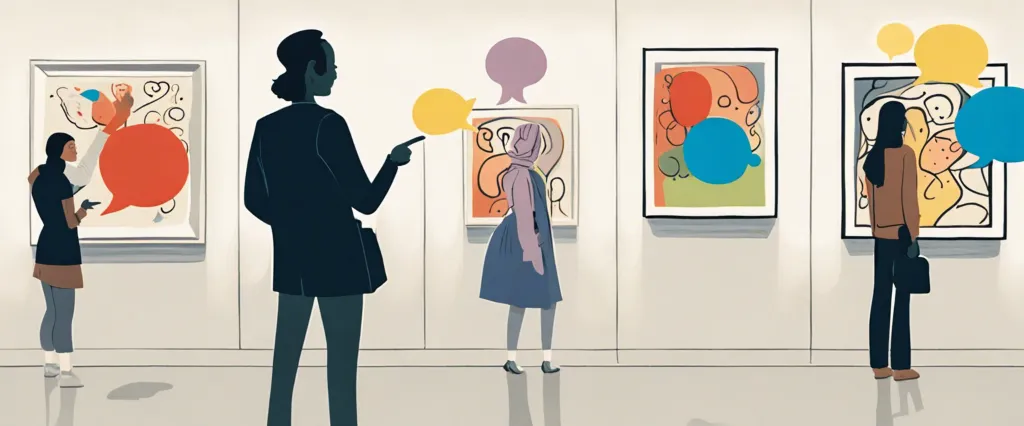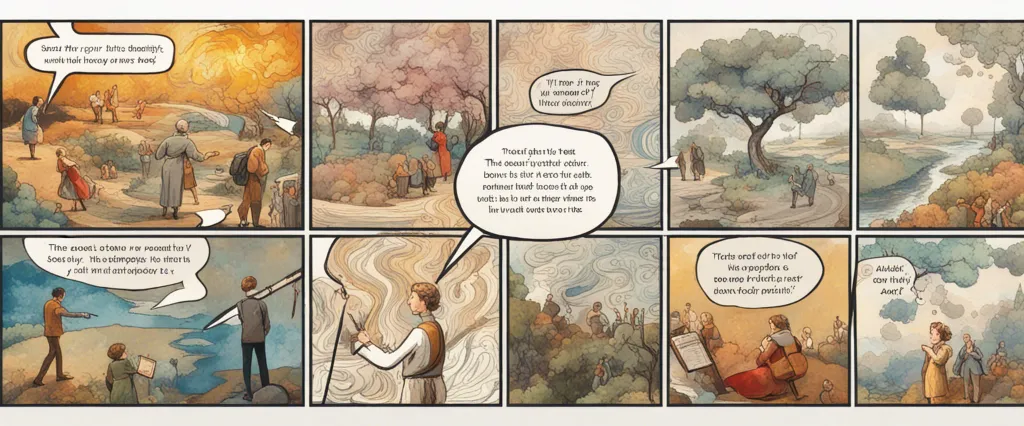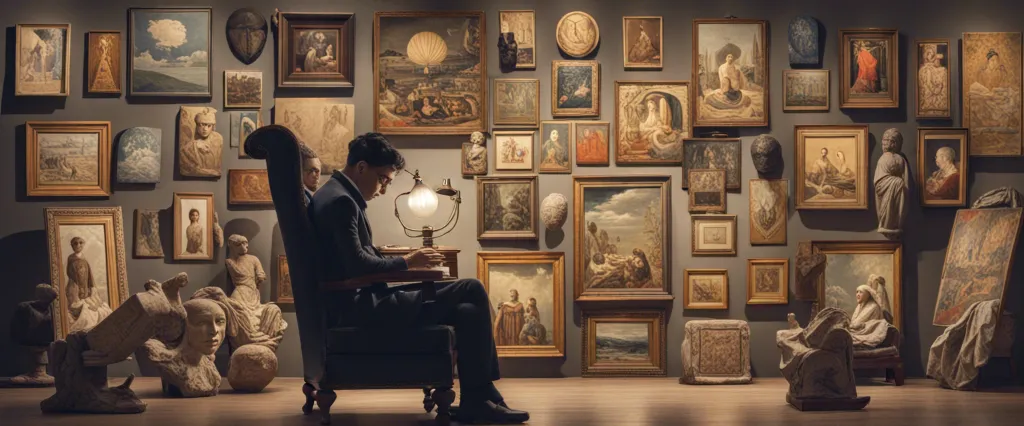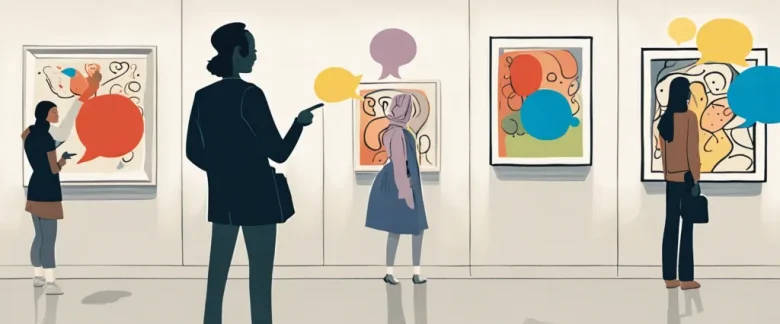
In his renowned work ‘The Story of Art,’ E.H. Gombrich presents a concise and captivating overview of the history of art. Originally published in 1950, Gombrich’s book has since become a cherished resource for art enthusiasts and novices alike. As an esteemed art historian and scholar, Gombrich dedicated his life to studying and unraveling the complexities of artistic expression. His unassuming approach and engaging narrative style make ‘The Story of Art‘ an accessible masterpiece, offering readers a panoramic journey through the vast tapestry of human creativity.
Chapter 1: The Beginnings of Art
Chapter 1 of “The Story of Art” by E.H. Gombrich is titled “The Beginnings of Art.” In this chapter, Gombrich explores the origins and evolution of art throughout human history. He takes readers on a journey from the prehistoric times to ancient civilizations such as Egypt, Mesopotamia, and Greece.
Gombrich starts by discussing the earliest forms of human artistic expression through cave paintings. He highlights the importance of these cave paintings as a means of communication and self-expression, providing insight into the lives and thoughts of our ancestors.
Moving forward, Gombrich examines the artistic traditions and achievements of ancient civilizations. He explores the emergence of figurative art in ancient Egypt, where sculptures and paintings depicted pharaohs, gods, and religious scenes. The complexity and symbolism of Egyptian art are discussed, as well as its connection to beliefs in the afterlife.
Gombrich also delves into the art of ancient Mesopotamia, where the invention of writing and the establishment of complex societies contributed to the development of monumental architecture and intricate reliefs. He emphasizes the importance of religion and power structures, which greatly influenced artistic themes and styles.
Lastly, Gombrich explores the influence of ancient Greece, a civilization known for its remarkable artistic achievements. He highlights the Greek emphasis on realism and the human form, as seen in their sculptural masterpieces such as the Parthenon sculptures.
Overall, this chapter lays the foundation for understanding the beginnings of art, showcasing how different cultures and civilizations made significant contributions to the evolution of artistic expression. By exploring the artistic traditions of prehistoric and ancient societies, Gombrich sets the stage for further exploration into the history of art throughout the rest of the book.
Chapter 2: The Art of Ancient Egypt
Chapter 2: The Art of Ancient Egypt in the book “The Story of Art” by E.H. Gombrich explores the unique artistic styles and themes of ancient Egyptian art. The chapter delves into the history and culture of this ancient civilization, providing a deeper understanding of their artistic principles and practices.
Gombrich begins by emphasizing the significance of the Nile River in shaping the lives of the ancient Egyptians. The Nile’s regular and predictable flooding helped create a stable society and enabled the growth of agriculture and trade. This stability allowed the Egyptians to focus on other pursuits, such as art and architecture.
The chapter discusses the concept of “ka,” the belief that each person possessed a spiritual double, which influenced the creation of art in ancient Egypt. The ka required a physical representation, leading to the creation of statues and murals to ensure its continued existence and companionship.
Gombrich describes the rigid and formal style of Egyptian art, which aimed to achieve permanence and immortality. Artists adhered to strict conventions, representing humans and animals in idealized forms. Faces were portrayed in profile, while bodies were depicted frontally, resulting in a combination of different viewpoints.
The chapter also explores the significance of hieroglyphics in Egyptian art. Hieroglyphics were a form of writing that employed symbols and pictorial representations. They were inscribed on temple walls, tomb paintings, and various artifacts, communicating stories and preserving historical events.
In conclusion, Chapter 2 provides a comprehensive overview of ancient Egyptian art, highlighting the unique features and cultural influences that defined this civilization’s artistic expression. The chapter’s detailed exploration of the art forms, techniques, and symbolic representations helps readers grasp the essence of ancient Egyptian art and its role in preserving their civilization’s history and beliefs.
Chapter 3: Classical Art and the Greek Ideal
Chapter 3 of E.H. Gombrich’s book “The Story of Art” explores Classical Art and the Greek Ideal. This chapter focuses on the development and key characteristics of art during the classical period in ancient Greece.
Gombrich begins by highlighting the influence of the Greeks on Western art. He explains that the Greeks considered art to be the embodiment of ideal beauty and sought to depict the human form in its most perfect and harmonious state. This belief in proportion and idealism strongly influenced the art of the classical period.
The chapter then delves into the portrayal of the human body, which became a central theme in Greek art. Gombrich explains how artists aimed to achieve the perfect balance between realism and idealism. They meticulously studied human anatomy and emphasized the idealized form, simultaneously capturing the naturalistic details of muscles and bones. This commitment to anatomical accuracy and harmony can be seen in sculptures like the Doryphoros (Spearbearer) by Polykleitos.
Gombrich also explores the development of the Acropolis, a fortified complex in Athens housing numerous magnificent architectural structures. He discusses the iconic Parthenon, which exemplifies the Greek pursuit of perfection. The Parthenon incorporates the concept of optical correction to create an illusion of perfect proportions, even though certain elements deviated slightly from true proportions to compensate for the viewer’s perspective.
The chapter concludes by discussing the classical ideal in pottery, specifically the black-figure and red-figure styles. These artists portrayed mythological and everyday scenes, making use of symmetrical compositions and attention to detail.
Overall, Gombrich’s Chapter 3 enlightens readers on the Greek ideal of art during the classical period. It demonstrates how the pursuit of perfection and the study of the human form influenced not only sculpture but also architecture and pottery. The legacy of classical Greek art continues to profoundly impact Western artistic traditions.
Chapter 4: The Art of Ancient Rome

Chapter 4: The Art of Ancient Rome in E.H. Gombrich’s book “The Story of Art” discusses the development and characteristics of Roman art during its various historical periods.
The chapter begins by highlighting the influence of Greek art on Roman culture, as the early Romans admired and imitated Greek art styles. Initially, this resulted in Roman art being a blend of Greek and Etruscan influences. However, as Rome expanded its empire, it absorbed numerous artistic traditions and incorporated them into a distinct Roman style.
Gombrich explores the story of Roman art through its evolving architectural achievements. He describes the early Roman Republic’s reliance on Greek architects and their construction of temples, such as the Temple of Portunus, in a Greek manner. Roman artists also emphasized the importance of portraiture, depicting individuals’ realistic likenesses, particularly during the Republican period.
As Rome transformed into an empire, it witnessed an artistic revolution. One of the most significant developments was the emergence of monumental architecture, prominently represented by the Colosseum, which showcased the technical mastery of the Roman engineers. The forum also served as a symbol of Roman identity, with its grand architecture and statues representing the power and wealth of the empire.
Furthermore, Gombrich delves into the subject of wall painting, describing the luxurious frescoes found in Roman villas. He discusses the use of perspective, creating the illusion of depth, and the artistic portrayal of landscapes and cityscapes.
The chapter concludes by examining the decline of Roman art as the empire faced political and economic challenges. It explores the shift towards a more decorative style and the preservation of earlier styles of art. The fall of the Roman Empire ultimately led to the disintegration of Roman artistic traditions, opening the door to new artistic movements in Europe.
Chapter 5: The Rise of Christianity and Byzantine Art
Chapter 5 of “The Story of Art” by E.H. Gombrich explores the development of Christianity and the corresponding rise of Byzantine art. After the fall of the Roman Empire, the new religion of Christianity began to gain prominence throughout Europe. Christianity’s teachings and the story of Jesus Christ became central to European culture, influencing both religious and artistic practices.
During this time, Byzantine art emerged as the primary form of religious expression. Byzantine artists aimed to create spiritual connections through their works, prioritizing the religious message over realistic representation. Iconography played a crucial role in Byzantine art, with images acting as a means to convey religious stories, affirm faith, and connect believers with the divine realm.
One of the notable features of Byzantine art was the use of mosaics. These intricate designs adorned the walls and ceilings of churches, enhancing the solemnity of religious spaces. The mosaics often depicted scenes from the Bible and the lives of saints, using a formal and symbolic style. Through the use of symbolic gestures, halos, and the presence of golden backgrounds, Byzantine artists sought to express the otherworldly nature of the divine.
Gombrich explains that Byzantine art had a significant influence on the development of European art for centuries to come. Its highly stylized, symbolic approach laid the foundation for the art of the Middle Ages and beyond. Moreover, the religious devotion and the use of art as a means of spiritual connection remained fundamental elements of Christian art throughout history.
In conclusion, Chapter 5 of “The Story of Art” highlights the rise of Christianity and its impact on the development of Byzantine art. This form of expression was characterized by its emphasis on religious devotion, symbolic representation, and use of mosaics. Byzantine art would leave a lasting legacy, shaping the trajectory of European art for centuries.
Chapter 6: The Renaissance and the Rebirth of Art
Chapter 6 of “The Story of Art” by E.H. Gombrich explores the transformative period known as the Renaissance and its impact on the rebirth of art. The chapter delves into various aspects of this era, including the rediscovery of classical knowledge, the rise of humanism, and the resulting changes in artistic techniques.
The Renaissance, which began in 14th-century Italy and subsequently spread across Europe, marked a significant departure from the artistic style and themes of the Middle Ages. Gombrich highlights the renewed interest in ancient Greek and Roman art, literature, and philosophy, which fueled a desire to emulate and surpass the achievements of antiquity.
One of the central tenets of the Renaissance was the shift towards humanism, emphasizing the potential and importance of human beings. Artists became increasingly fascinated with depicting the human form in a realistic and naturalistic manner. This required understanding the human anatomy, resulting in the study of cadavers and the development of techniques such as linear perspective to create depth and dimensionality.
Gombrich discusses the influential figures of the Renaissance, such as Donatello, Leonardo da Vinci, and Michelangelo, who epitomized the new appreciation for the human form and its beauty. These artists pursued a rich variety of subjects, producing sculptures, paintings, and architectural marvels that reflected the newfound emphasis on individualism and the human experience.
The chapter further explores the expansion of artistic patronage during the Renaissance, with numerous wealthy families and institutions commissioning artworks. This encouraged experimentation and innovation, pushing artists to constantly seek new ways to convey their artistic visions.
In summary, Chapter 6 of “The Story of Art” reveals how the Renaissance brought about a revival of classical knowledge, a shift towards humanism, and profound changes in artistic techniques. It showcases the remarkable artworks that emerged during this period and highlights the societal and cultural shifts that forever transformed the world of art.
Chapter 7: Baroque and Rococo: Splendor and Sensuality
Chapter 7 of “The Story of Art” by E.H. Gombrich explores the artistic movement of Baroque and Rococo, which emerged in Europe during the 17th and 18th centuries. The chapter provides a detailed overview of the main characteristics, themes, and artists associated with these periods.
Gombrich begins by explaining that the Baroque era was characterized by a grand and extravagant style, often commissioned by religious institutions. This period marked a transition from the calm and balanced compositions of the Renaissance to a more dynamic and dramatic style. Artists such as Gian Lorenzo Bernini in Italy and Peter Paul Rubens in the Netherlands exemplified the Baroque sensibility through their elaborate sculptures and paintings, which aimed to engage the viewers emotionally.
The author then shifts focus to Rococo, a more delicate and refined style that emerged during the late Baroque period. Rococo art was characterized by its playful and decorative qualities, often featuring intricate pastel colors, curling lines, and whimsical subjects. Jean-Antoine Watteau, François Boucher, and Jean-Honoré Fragonard were prominent artists of the Rococo period, known for their intimate and lighthearted portrayals of aristocratic leisure activities and romantic scenes.
Gombrich also highlights the influence of religious reforms and societal changes on the development of Baroque and Rococo art. He discusses the Counter-Reformation and how the Catholic Church used art as a tool to reaffirm its power and engage the emotions of the faithful. Additionally, the author emphasizes the role of the expanding bourgeoisie in commissioning and appreciating Rococo art, which often focused on the pleasures of everyday life.
In summary, Chapter 7 provides a comprehensive overview of the grandeur and sensuality of Baroque and Rococo art, highlighting the major artists and themes of these periods while shedding light on the broader historical context that influenced their development.

Chapter 8: From Impressionism to Modern Art
Chapter 8: From Impressionism to Modern Art of the book “The Story of Art” by E.H. Gombrich takes readers on a journey through the evolution of art from the late 19th to the early 20th century. This period witnessed significant shifts in artistic styles and approaches, as artists sought to break away from traditional norms and explore new ideas.
The chapter starts with the Impressionist movement, which emerged in France in the late 1800s. Impressionist painters sought to capture the fleeting moments of modern life, focusing on the effects of light and color. Artists like Monet, Renoir, and Degas abandoned the precise details and instead embraced quick, loose brushstrokes to convey a sense of immediacy.
The narrative then moves onto the Post-Impressionists, such as Cézanne, Van Gogh, and Gauguin. These artists further questioned the limitations of traditional representation by experimenting with form, color, and perspective. Cézanne, in particular, explored the geometrical elements of nature, paving the way for Cubism.
Gombrich then delves into Symbolism, a movement characterized by metaphorical and allegorical representations of the inner world. Painters like Munch and Redon aimed to convey emotions and psychological states through haunting and dreamlike imagery.
The chapter concludes with an exploration of the birth of abstraction in the early 20th century. Artists like Kandinsky and Mondrian rejected the need for recognizable subject matter, instead focusing on the purity of form, color, and the spiritual essence of art.
Overall, Chapter 8 summarizes the revolutionary changes that took place during this period, as artists experimented with new techniques, shattered traditional conventions, and paved the way for modern art as we know it today.
After Reading
In conclusion, E.H. Gombrich’s “The Story of Art” provides a comprehensive and accessible overview of the history of art. Through eloquent prose and insightful analysis, Gombrich explores various artistic movements, from ancient cave paintings to modern masterpieces. He highlights the evolution of artistic techniques, styles, and themes, emphasizing the interconnectedness of different cultures and epochs. Gombrich’s book serves as an invaluable resource for both art enthusiasts and beginners, offering a deep appreciation for the ever-evolving narrative of art and its profound impact on human history.
1. Sapiens: A Brief History of Humankind” by Yuval Noah Harari – In this thought-provoking book, Harari offers a compelling narrative that explores the history of our species from the emergence of Homo sapiens in Africa to the present day. The book offers insights into the development of humanity, our social structures, and the impact of our actions on the world.
2. The Alchemist” by Paulo Coelho – This beautifully crafted novel takes readers on a journey of self-discovery and personal growth. Through the story of a young shepherd named Santiago, Coelho imparts timeless wisdom about following one’s dreams, finding meaning in life, and the power of intuition.
3. 1984″ by George Orwell – A dystopian classic, Orwell’s masterpiece paints a haunting picture of a totalitarian regime where individualism is suppressed and citizens are subject to constant surveillance. This chilling novel serves as a warning against the dangers of unchecked power and the erosion of freedom.
4. The Immortal Life of Henrietta Lacks” by Rebecca Skloot – This remarkable work of non-fiction delves into the fascinating true story of a woman named Henrietta Lacks, whose cells were taken without her consent and became instrumental in numerous medical breakthroughs. Skloot explores the ethical implications of this case while raising questions about race, class, and our relationship to science.
5. “The Kite Runner” by Khaled Hosseini – Set against the backdrop of Afghanistan’s tumultuous history, this unforgettable novel follows the lives of two childhood friends, Amir and Hassan, as their destinies intertwine. Hosseini’s evocative storytelling explores themes of loyalty, redemption, and the power of forgiveness in the face of remorse.



